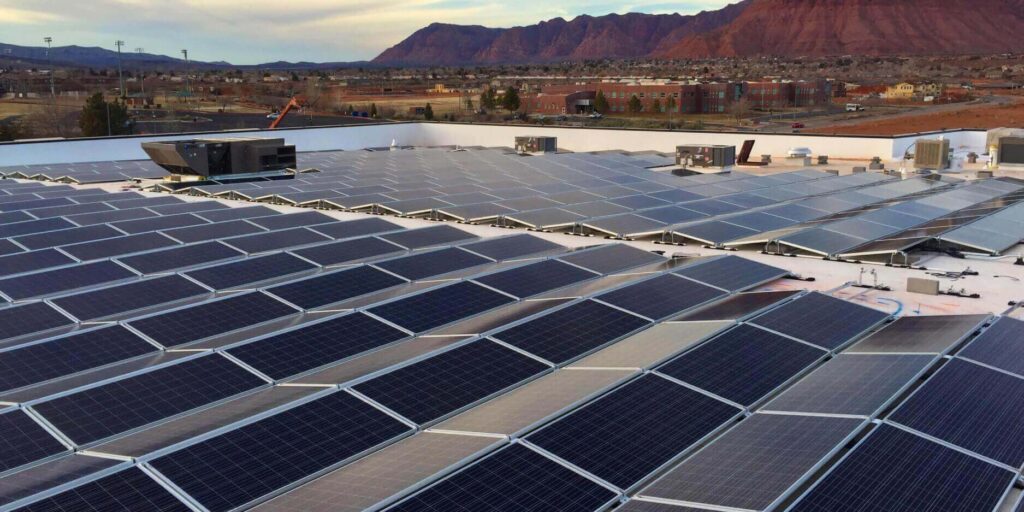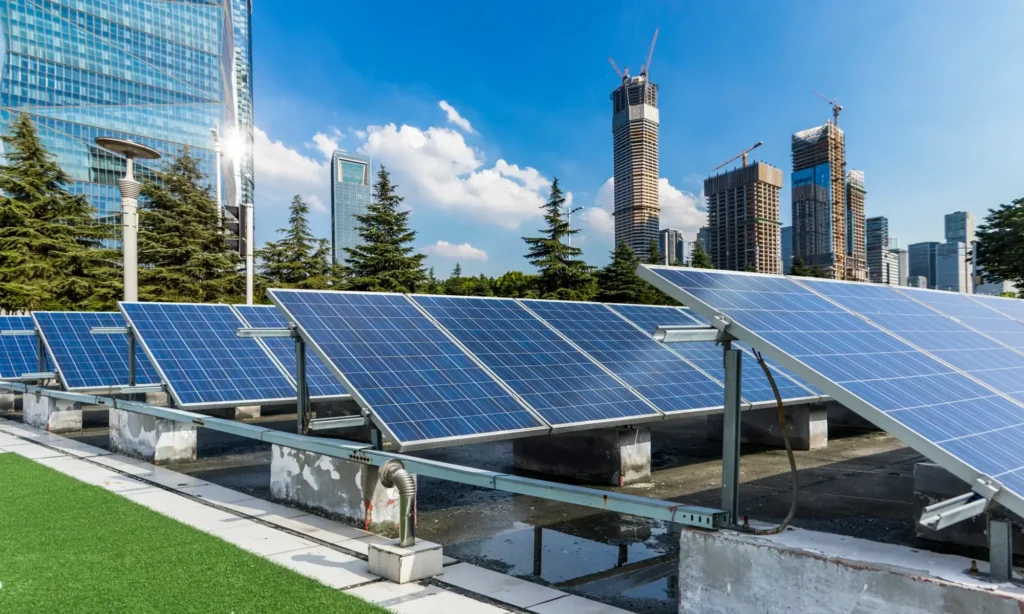In today’s business landscape, sustainability is no longer just a buzzword—it’s a necessity. With increasing environmental awareness and the urgent need to combat climate change, companies are under pressure to adopt greener practices. Among these, commercial solar systems have emerged as a revolutionary solution, enabling businesses to reduce their carbon footprint while reaping economic benefits.
By harnessing the power of the sun, commercial solar systems offer an innovative way for businesses to generate clean energy, cut costs, and enhance their reputation as environmentally conscious entities. But what exactly makes them the future of business sustainability? Let’s explore.
Understanding Commercial Solar Systems
What Are Commercial Solar Systems?
A commercial solar system is a large-scale solar energy setup designed to meet the energy demands of businesses. Unlike residential solar systems, which cater to homes, commercial setups are tailored for industrial facilities, office buildings, and retail spaces.
How They Differ From Residential Solar Systems
- Scale: Commercial systems are larger, designed to power significant energy loads.
- Purpose: While residential systems focus on lowering home energy bills, commercial setups aim to maximize efficiency and profitability.
- Complexity: Installation and maintenance involve advanced technologies and expertise.
Key Components of a Commercial Solar System
- Solar Panels: The core component that captures sunlight and converts it into electricity.
- Inverters: Devices that transform direct current (DC) into usable alternating current (AC).
- Mounting Systems: Structures that secure solar panels in place, either on rooftops or ground-mounted setups.
- Battery Storage (Optional): Stores excess energy for use during low sunlight periods.
Why Businesses Are Shifting to Solar
Environmental Benefits
Businesses adopting solar energy significantly reduce greenhouse gas emissions. By switching to solar, companies contribute to global sustainability goals and demonstrate their commitment to fighting climate change.
Economic Incentives and Cost Savings
Governments worldwide offer financial incentives, including tax breaks, subsidies, and rebates, to encourage solar adoption. Additionally, businesses can save thousands annually on energy costs by relying on free, renewable solar power.
Meeting Consumer Expectations
Today’s consumers prefer to support brands that prioritize sustainability. Solar-powered businesses gain a competitive edge by appealing to eco-conscious customers, fostering brand loyalty, and enhancing their market position.
How Commercial Solar Systems Work
The Science Behind Solar Energy
Solar panels use photovoltaic (PV) cells to absorb sunlight and convert it into electricity. This energy is either used immediately or stored in batteries for later use.
Types of Solar Panels Used
- Monocrystalline Panels: Highly efficient and space-saving.
- Polycrystalline Panels: Cost-effective and durable.
- Thin-Film Panels: Lightweight and flexible, suitable for unique installations.
Installation and Operation
- Site Assessment: Experts evaluate your location to determine optimal panel placement.
- System Design: A customized layout maximizes energy production.
- Installation: Panels are installed, wired to inverters, and connected to the grid or battery storage.

Benefits of Commercial Solar Systems
Reduction in Energy Costs
One of the most immediate benefits is the drastic reduction in energy expenses. Solar energy replaces grid electricity, leading to significant monthly savings.
Long-Term Financial Savings
Although the initial investment may seem substantial, the return on investment (ROI) is substantial. Businesses save more over the system’s 25-30 year lifespan, offsetting initial costs.
Enhancing Corporate Social Responsibility (CSR)
By adopting solar, businesses showcase their commitment to environmental responsibility. This enhances their CSR profile, attracting partners, investors, and customers who value sustainability.
Economic Viability and ROI
Initial Investment and Financing Options
Commercial solar installations require upfront investment, but financing options like solar loans and power purchase agreements (PPAs) make them accessible.
Break-Even Points and Payback Periods
Most businesses achieve ROI within 5-10 years. After this period, they enjoy free electricity for decades.
Government Incentives and Tax Benefits
Governments often provide tax credits, grants, and depreciation benefits, further improving the financial feasibility of going solar.
Overcoming Challenges in Adopting Solar
Common Barriers to Adoption
Despite the many benefits, businesses may face challenges when transitioning to solar power. Common obstacles include high upfront costs, lack of awareness, and concerns about system efficiency or reliability.
Technological Advancements Addressing These Issues
Innovations in solar technology are continuously improving efficiency and affordability. For example:
- High-efficiency panels now generate more power from smaller installations.
- Energy storage solutions ensure businesses can use solar energy even during non-sunny periods.
- Smart monitoring systems provide real-time data, helping optimize energy usage and maximize savings.
Success Stories of Businesses Overcoming Challenges
Many businesses have successfully adopted solar despite initial hesitations. For example:
- Small retailers have used government subsidies to offset costs.
- Industrial facilities have taken advantage of tax breaks and achieved ROI faster than anticipated.
- These stories inspire confidence in the long-term viability of solar power.
Choosing the Right Solar System for Your Business
Factors to Consider
When selecting a commercial solar system, it’s essential to evaluate several factors:
- Energy Requirements: How much power does your business consume daily?
- Space Availability: Do you have sufficient rooftop or ground space for installation?
- Budget: What is your initial investment capacity?
Importance of Conducting an Energy Audit
An energy audit provides a detailed understanding of your energy consumption patterns. This ensures the chosen solar system meets your specific needs and eliminates unnecessary expenses.
Working With Certified Installers
Partnering with licensed and experienced installers ensures the system is designed and installed correctly. Look for certifications such as NABCEP (North American Board of Certified Energy Practitioners) or regional equivalents.
Case Studies: Successful Solar-Powered Businesses
Example 1: Retail Chains
A well-known retail chain installed rooftop solar panels across multiple locations. Results:
- 30% reduction in energy costs.
- Enhanced brand image as an eco-friendly business.
Example 2: Manufacturing Plants
A manufacturing company integrated solar systems into its operations, reducing its reliance on grid electricity. Results:
- 40% decrease in operational energy costs.
- Qualifying for additional government incentives.
Example 3: Tech Startups
Startups in coworking spaces adopted solar power, using it as a selling point to attract environmentally conscious clients. Results:
- Improved client retention and satisfaction.
- Recognition as a green innovation leader.
Solar Energy and the Future of Business Sustainability
Trends in Solar Technology
The solar industry is evolving rapidly, with advancements such as:
- Bifacial Panels: These capture sunlight from both sides, increasing efficiency.
- Perovskite Solar Cells: Promising higher energy conversion rates at lower costs.
- Solar Tracking Systems: These adjust panel angles to maximize sunlight exposure throughout the day.
Predictions for Solar Adoption in Businesses
By 2030, it’s estimated that solar power will dominate as the primary energy source for businesses globally. Factors driving this include falling installation costs and increasing environmental regulations.
Role of Innovation in Driving Adoption
Innovative financing models, such as pay-as-you-go systems, and partnerships with energy providers are making solar more accessible to small and medium-sized businesses.
The Role of Government Policies
How Government Support Accelerates Solar Adoption
Government initiatives play a critical role in encouraging businesses to go solar. Policies such as net metering allow businesses to sell excess power back to the grid, further increasing savings.
Country-Specific Policies for Businesses
- United States: Federal Investment Tax Credit (ITC) and state-specific incentives.
- European Union: Subsidies under the European Green Deal.
- India: Solar rooftop subsidy programs for commercial entities.
Importance of Staying Updated on Incentives
As policies evolve, businesses must stay informed to maximize financial benefits. Working with consultants can help navigate the legal and financial landscape effectively.

Myths and Misconceptions About Solar Systems
Myth 1: Solar Energy Is Too Expensive
Reality: While the initial cost is high, the long-term savings and government incentives often outweigh these expenses.
Myth 2: Solar Panels Don’t Work in Cloudy Weather
Reality: Modern solar panels are designed to capture even diffused sunlight, ensuring consistent energy generation.
Myth 3: Maintenance Is Too Complicated
Reality: Solar panels require minimal maintenance, with most systems only needing annual inspections and occasional cleaning.
Myth 4: Solar Panels Are Not Durable
Reality: Most panels are built to withstand harsh weather conditions and last 25-30 years with warranties to match.
Integrating Solar With Other Green Initiatives
Combining Solar With Energy-Efficient Practices
Pairing solar power with energy-efficient measures, such as LED lighting and smart thermostats, amplifies savings and sustainability.
Benefits of a Holistic Sustainability Strategy
Adopting a comprehensive approach ensures businesses achieve their sustainability goals more effectively. This may include:
- Waste reduction programs.
- Water conservation strategies.
Examples of Businesses Achieving Net-Zero
Large corporations, including tech giants and multinational retailers, have publicly committed to achieving net-zero emissions by integrating solar and other renewable energy sources into their operations.
The Competitive Edge of Solar-Powered Businesses
Boosting Brand Image
Businesses powered by solar are seen as pioneers in environmental responsibility. This enhances their reputation among stakeholders and consumers alike.
Attracting Eco-Conscious Consumers
Solar adoption resonates with the values of modern consumers who prioritize sustainability. This helps businesses build stronger customer loyalty.
Staying Ahead in a Competitive Market
With energy prices rising, solar-powered businesses have a distinct advantage by reducing operational costs and remaining agile in pricing strategies.
Conclusion
The transition to commercial solar systems is not just a trend—it’s a necessity for businesses aiming to stay relevant in an increasingly eco-conscious world. From significant cost savings to enhanced brand reputation and contributions to global sustainability goals, the benefits are undeniable.
For businesses ready to embrace the future, the shift to solar power represents a step toward innovation, resilience, and environmental stewardship.
FAQs
- What is the lifespan of a commercial solar system?
Commercial solar systems typically last 25-30 years, with warranties ensuring performance over this period. - Are commercial solar systems suitable for all industries?
Yes, they are versatile and can be tailored to meet the needs of various sectors, including retail, manufacturing, and hospitality. - How much can a business save by switching to solar?
Savings vary, but businesses often reduce their energy costs by 30-50%, depending on the size and efficiency of their solar system. - What happens to solar panels during extreme weather?
Most solar panels are designed to withstand harsh weather conditions, including hail, heavy rain, and strong winds. - How does solar energy contribute to sustainability goals?
Solar energy reduces reliance on fossil fuels, lowers carbon emissions, and supports renewable energy targets, making it integral to sustainability initiatives.
